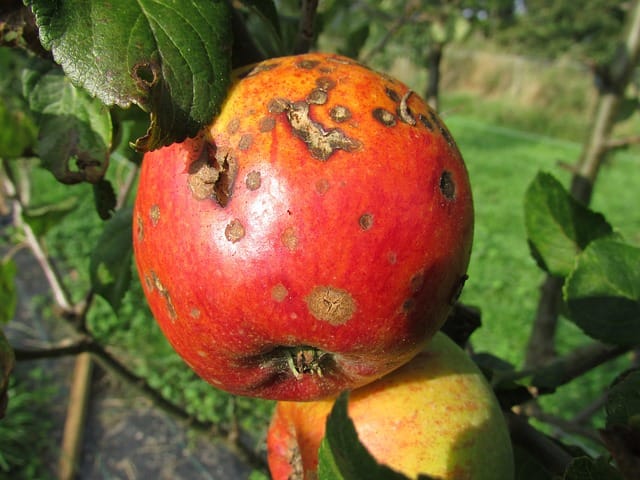Fighting gardening diseases: Apple scab
Gardening diseases can pose a significant threat to the health and productivity of apple trees

In this article:
- Introduction
- Understanding Apple Scab
- Identifying Apple Scab Symptoms
- Apple Scab: Causes and Spread
- Impact of Apple Scab on Apple Trees
- Preventive Measures for Apple Scab
- Cultural Control Techniques
- Chemical Control Options for Apple Scab
- Organic Alternatives for Apple Scab Management
- Timing and Schedule for Apple Scab Control
- Integrated Pest Management for Apple Scab
- Resistant Apple Varieties
- Importance of Proper Pruning and Sanitation
- Apple Scab: Treatment and Management
- Long-term Strategies for Apple Scab Prevention
- Conclusion and Final Thoughts
Introduction
Gardening diseases can pose a significant threat to the health and productivity of apple trees. One common disease that gardeners often encounter is apple scab. This article aims to provide you with a comprehensive understanding of apple scab and effective strategies for its prevention and management.
Understanding Apple Scab
Apple scab is a fungal disease caused by the pathogen Venturia inaequalis. It primarily affects apple trees but can also infect other plants in the Rosaceae family. The disease is prevalent in regions with humid climates and cool springs.
Identifying Apple Scab Symptoms
Early detection of apple scab symptoms is crucial for effective management. Look for olive-green or brownish circular lesions that develop on leaves, fruit, and stems. These lesions may have a velvety or rough texture, and in severe cases, they can cause leaf distortion and premature defoliation.
Apple Scab: Causes and Spread
Apple scab spreads through fungal spores that can be present in soil debris, fallen leaves, or infected plant material. These spores are dispersed by wind, rain, or human activities, facilitating the disease's spread from one tree to another.
Impact of Apple Scab on Apple Trees
Untreated apple scab can severely impact the overall health and productivity of apple trees. The disease weakens the tree by reducing its photosynthetic capacity, leading to decreased fruit yield, poor fruit quality, and stunted growth.
Preventive Measures for Apple Scab
Prevention is key to avoiding apple scab. Choose disease-resistant apple varieties, maintain proper tree spacing, and site selection to increase airflow and reduce humidity. Additionally, follow good sanitation practices by removing and destroying infected plant material.
Cultural Control Techniques
Implement cultural control techniques such as regular pruning to improve air circulation within the canopy and reduce moisture retention. Proper irrigation practices should be followed to avoid wetting the leaves, and mulching can help prevent soil splashing onto the foliage.
Chemical Control Options for Apple Scab
Chemical control options include the use of fungicides specifically formulated to combat apple scab. Contact your local agricultural extension office or a certified horticulturist to determine the appropriate fungicides and application timings for your specific location.
Organic Alternatives for Apple Scab Management
If you prefer organic alternatives, several options are available. These include the use of copper-based fungicides, neem oil, sulfur-based products, and biological control agents. Always follow the label instructions and apply these products at the recommended timings.
Timing and Schedule for Apple Scab Control
Effective timing for apple scab control revolves around the disease's life cycle. Applying preventive fungicides before infection occurs is critical. Regular monitoring of temperature and moisture levels can help determine the appropriate schedule for spraying and other control measures.
Integrated Pest Management for Apple Scab
Integrated Pest Management (IPM) incorporates multiple strategies to manage apple scab effectively. This approach includes the judicious use of cultural control techniques, regular monitoring, and the integration of chemical and organic control methods when necessary.
Resistant Apple Varieties
Choosing apple varieties that exhibit natural resistance to apple scab can significantly reduce the disease's impact. Consult with local nurseries or extension services to identify resistant cultivars that are suitable for your growing region.
Importance of Proper Pruning and Sanitation
Proper pruning techniques, such as removing dead or infected branches, can help increase sunlight penetration and improve air circulation, minimizing favorable conditions for apple scab development. Sanitation practices, including the removal and disposal of fallen leaves, can further reduce the disease's spread.
Apple Scab: Treatment and Management
If apple scab is already present in your orchard, a combination of cultural control techniques, targeted fungicide applications, and sanitation practices can help manage the disease. Consult with local experts for specific treatment recommendations.
Long-term Strategies for Apple Scab Prevention
To achieve long-term prevention, it is crucial to maintain a holistic approach to orchard management. This includes careful site selection, proper plant care, regular monitoring, timely interventions, and ongoing research to stay updated on the latest management practices.
Conclusion and Final Thoughts
Apple scab is a challenging disease, but with the right knowledge and proactive measures, it can be effectively managed and prevented. By implementing preventive and control strategies, you can safeguard the health and productivity of your apple trees, ensuring bountiful harvests for years to come.
